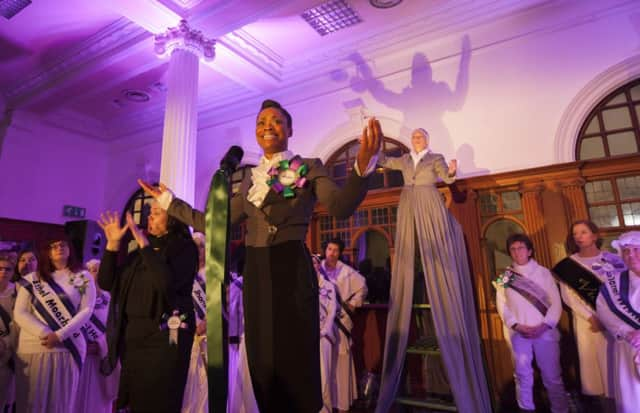Joyce McMillan: The inspirational March of Women


Saturday lunchtime, Landressy Street, Glasgow, and the weather is gloomy; but there’s no dampening the enthusiasm of the dozens of women who are converging on Glasgow Women’s Library, most of them dressed in white, with sashes or rosettes in the suffragette colours of green and violet. The date is 7 March, with just hours to go before the dawn of International Women’s Day 2015; and the occasion is Glasgow’s March Of Women, a powerful combination of theatre show, pageant, and cheerful demonstration, designed to remind us of the great and often largely unknown women who have helped to shape Scotland’s past and present.
The theatre show – presented in the gracious main reading room of the library – is a powerful community effort, based on the 1910 Pageant Of Great Women by English actress and women’s suffrage campaigner Cicely Hamilton. Three professional actors – Lucianne McEvoy, Patricia Panther and Lesley Hart – play the goddess Justice, sitting high on her throne, scales in hand; along with a young woman striving for equality, and a classic male chauvinist, arguing the case against her.
Advertisement
Hide AdAnd when it comes to giving that evidence, the show’s hundred-strong community cast comes to the fore, all in white, many in fine Edwardian costume, each wearing a sash bearing the name of a woman artist, scientist, or campaigner whose achievements, often against considerable odds, fairly take the breath away. And once the show is over, we all gather in the street and march to Glasgow Green, to hang banners on the old clothes-poles that remind us of the generations of women who once used to hang their washing here.
As a piece of theatre, the whole event is rough-edged, its intentions blindingly clear, its execution sometimes patchy. Watching it, though, I feel three powerful emotions. The first is sheer admiration for the great women the show commemorates, and for the East End community of women who have come together so powerfully to commemorate them. The second is a kind of shame that, despite calling myself a feminist for decades, I still know so few of these stories, recognise so few of the names.
And the third is a surge of sheer appreciation for the role theatre plays, as a public art-form often capable of operating on a shoe-string, in rediscovering stories otherwise untold, and bringing them back into the public domain. This is true of groups other than women, of course; all that I know about the history of Scotland’s travelling people, or Italian communities in Scotland in 20th century, or the 19th century campaign for land rights in the Highlands, I owe to theatre shows that celebrated these stories.
When it comes to women, though, the effect is striking; during the March Of Women, I realise that over the years, I have seen plays made in Scotland about at least five of these little-known women, including the Strichen-born Hollywood scriptwriter Lorna Moon, the charity worker Jane Haining (who was one of only three Scottish women to die in Nazi concentration camps), and the mighty explorer Isabella Bird Bishop, who features in Caryl Churchill’s Top Girls, one of the great women’s plays of the late 20th century. And next month, to mark the centenary of her death, Dundee Rep revives Mother Of All The Peoples, Mike Gibb and Mairi Warren’s celebration of the life of the great missionary, Mary Slessor.
So perhaps, for International Women’s Day 2016, it might be worth considering a mini-festival of plays about women who should be better known to us; there must be a dozen others, beyond the handful recalled by last Saturday’s pageant. And it’s perhaps time, too, for more thought about how the fact of injustice fuels some of our greatest theatre; as if, in giving a public voice to the voiceless and unheard, this art-form finds its greatest purpose, and one of its most vital sources of creative energy.